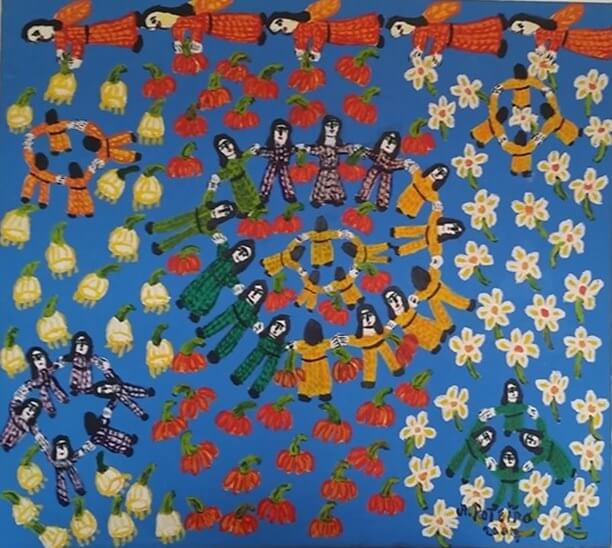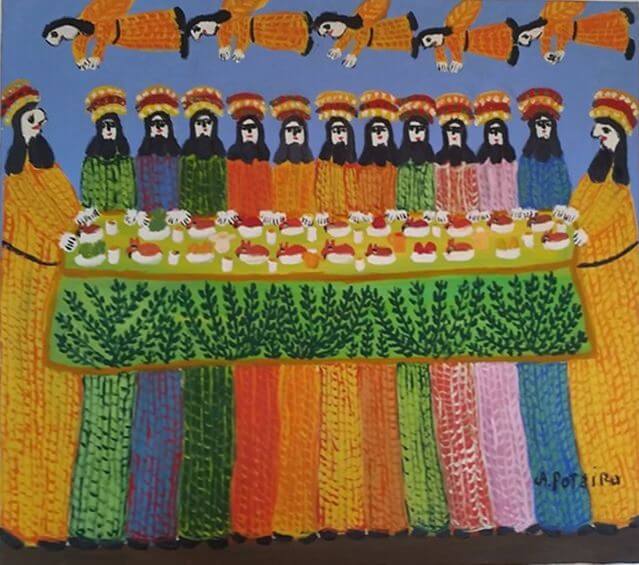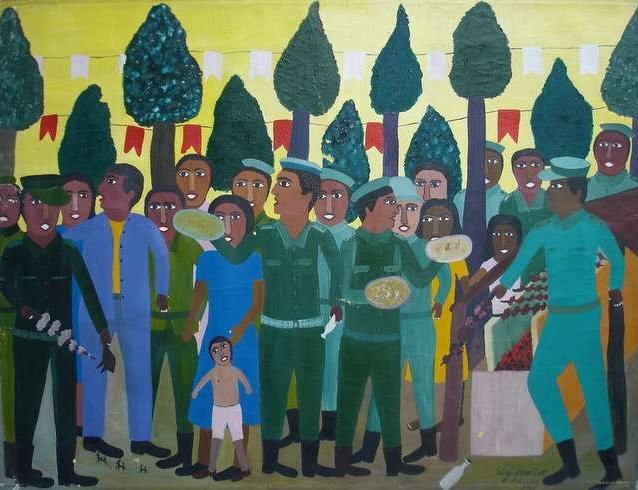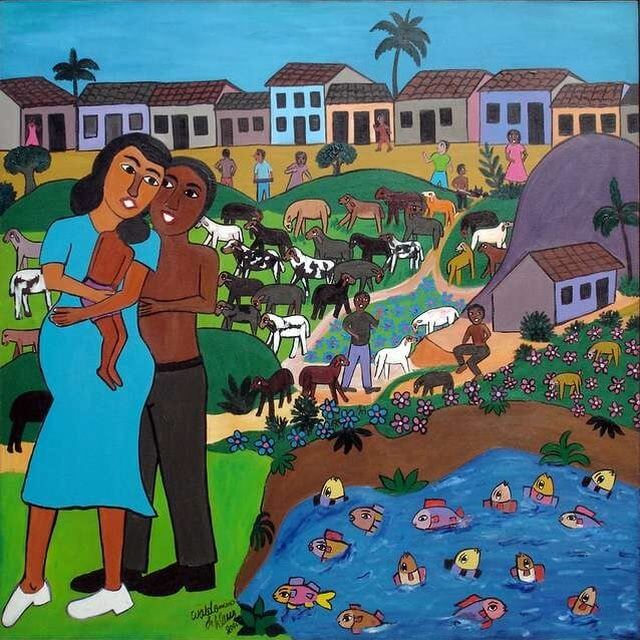You can also listen to this article in the voice of own Plastic Artist Rosângela Vig:

The Beautiful Art
[one_half]
In the picture I ask myself
– trace the trace –
Sometimes I paint cloud
Sometimes I paint tree…Sometimes I paint things
That there's no more memories…
Or things that don't exist
But one day there will be…And this deal that I seek
– little by little –
My eternal similarity.At the end will be left?
A child's drawing…
Corrected by a mad!
(QUINTANA, 2004, p.47)[/one_half][one_half_last][/one_half_last]

It is the almost child trace, the artist outlines his characters that are between the people and the regional customs. Amid flower gardens and birds, the angry people are in bullock carts, in overalls and little horses. There are characters of our History, of our day to day, of our folklore, processions, animals of our fauna and many Christmases, here with simple lines, without concern for the shape, because the important thing is making art, pure, loosely. This is the Naif style and is explained by itself, in simplicity, in innocence, as beautiful as the sonnet of Mário Quintana (1906-1994).

As a definition, the term Naif, in French, means natural, spontaneous, ingénue, so how is this artistic practice, that gave Henri Rousseau 1 (1844-1910), the title of precursor and icon. Self-taught and with a unique style and differential, the artist came to be ridiculed and, only in the early twentieth century, when the Primitivism 2 resumed strength, artists of the avant-garde changed their look at the Naive Art. The French writer Alfred Jarry, admirer of his work, presented Rosseau the bohemian group of Paris. Picasso came to buy her works and to honor him. Other intellectuals, as Apollinaire and Delaunay became admirers of his work. Although the light style to the idea of simplicity, Rosseau thoroughly studied every detail, modified perspective and combined fanciful elements.

Confuses the Naive Art, and often, with the idea of popular, but this type of paint is primarily concerned with flight of traditional patterns, present at Art western, how perspective and anatomy. The artist makes use of bright colors and vivid; There are a wealth of detailed and colorful decorative elements, that often recur, which leads to a feeling innocent end of joy to the work. Without the influence of schools of Fine Arts, the artist developed his own way of interpreting reality and culture, from own experiences, led by the urge to immortalize a moment.

In Brazil, among the icons of Naive Art are Heitor dos Prazeres (1898-1966), José Antônio da Silva (1909-1996), Cardosinho (1861-1947), Chico da Silva (1910-1985), Grauben (1889-1972), and many other, especially here, to Antônio Poteiro 3 (1925-2010), sculptor, ceramist and painter, from portuguese nationality, who lived in Goiânia; and Waldomiro de Deus 4 (1944-), Brazilian painter, from Bahia, who now lives in São Paulo. The works of these great artists recognized, whose images illustrate the text, demonstrate this waiver of academic and a return to primitivism.


The work of Poteiro proves that Beauty, in Art, is not connected to correspondence with symmetry or reality, but it is clear the significant and expressive character that it flows. The Beauty of its Ciranda (Fig. 1) does not emanate from the perspective, but the play innocent, of cheerful colors that intertwine in an endless run; the flutter of flowers by the movement of children; of angels who bless all, from above. And the sieve of angels, fly to bless a Holy Communion (Fig. 2) abundant, beautiful and colorful. The Potter doesn't look like that of Da Vinci, the sky very blue leaves obvious that the day is sunny, as the days of Brazil, but the guests are the same. The ox-cart (Fig. 3) passes as a slow procession; It is possible that your move and, a look slower, hear even the sound of hoofbeats on the earthen floor. The flower garden frames the top of the screen; their yellow flowers, larger than the birds are repeated providing reassurance to look. It may be that the washerwomen, with their baskets (Fig. 4), are observing the refugees queue taking everything they own by mule. They seem to change, a slow move, continuous, silent. In Brazils that portrayed Poteiro, there are birds in flight or lonely in their nests; there are alligators, herons (Fig. 5), and so many animals that he must have seen in Goiás; there gardeners (Fig. 6); there are characters wielding their swords, heroes, equal to so many Brazilians.

Amid the endless beauty Naif, religiousness, is illustrated in the work of Waldomiro de Deus, where wages a struggle to rise to heaven (Fig. 7). Angels, in aid protected, arm struggle against the demons that surround. White and red flags adorn the common scene of a barbecue (Fig. 8), to which were invited all types, of all colors, as in Brazil of Waldomiro. It’s through the artist’s hands, the true happiness icon is portrayed in simple (Fig. 9), in the family. Around the protagonists of the scene, the houses, loose animals, the lake teeming with fish, people, a flower garden and the very blue sky. All scenes are in the midst of a very cheerful color, as is the Brazilian people.

The Naif works touring by the Beauty, because they are bucolic, featuring scenes of unspeakable simplicity, a regional with which the artists themselves live. A Brazil full of nature, water, animals and customs. All this, plus a large presence of the spiritual, of Christmas, the Birth of Jesus, in national version. Colors conform to the meaning of the work, just right, in sweetness, the simplicity, and alternate between green, yellow, whites, blues, red, giving to all, a poetic sense.
Maybe if Mário Quintana had described the Naif works of Antônio Poteiro or Waldomiro de Deus, he could not say, just looking at them, let the enjoyment passed by the look and penetrate the spirit. Because the Beauty is like that, spontaneous, emanates from the soul, from dreams, has poetry, although it is far from a correspondence with reality. And this text, which began with a poet, closes with a poetess,
We should be able to prepare our dreams as artists, his compositions. With the subtle matter of the night and our soul, We should be able to build these small masterpieces incommunicable which, even less than the pink, only the last moment in which they are dreamed, and then go off without another sign that our memory. (Text: Escolha seu sonho, MEIRELES, 1988, p.10)

1 Henri Rosseau:
www.henrirousseau.org
2 The Primitivism was never a movement, but a trend, that inspired many artists of the avant-garde of the early twentieth century, as Gauguin. The artist moved to Tahiti, where he lived with the artisans and indigenous peoples, that inspired him to produce an Exotic Art, free of form, closer to their instinct and using pure colors. Artists such as Pablo Picasso (1881-1973), Henri Matisse (1869-1954) and Amedeo Modigliani (1884-1920), were also supporters style and began working with the idea of simple lines and symbolic.
3 Instituto Antônio Poteiro:
www.antoniopoteiro.com
4 Waldomiro de Deus:
pt.wikipedia.org/wiki/Waldomiro_de_Deus
…
Liked? [highlight]Leave a comment[/highlight]!
References:
- BAYER, Raymond. História da Estética. Lisboa: Editorial Estampa, 1993. Tradução de José Saramago.
- FARTHING, Stephen. Tudo Sobre a Arte. Rio de Janeiro: Sextante, 2011.
- GOMBRICH, E.H. A História da Arte. Rio de Janeiro: Editora Guanabara, 1988.
- HAUSER, Arnold. História Social da Arte e da Literatura. Martins Fontes, São Paulo, 2003.
- MEIRELES, Cecília. Janela Mágica. São Paulo: Ed.Moderna, 1988.
- QUINTANA, Mário. Quintana de bolso. Porto Alegre: Ed.L & PM, 2004.
The figures:
Fig. 1 – Ciranda, OST, 90 cm x 1 meters. Antônio Poteiro.
Fig. 2 – Holy Supper, OST, 90 cm x 1 meters. Antônio Poteiro.
Fig. 3 – Carro de Boi, OST, 90 cm x 1 meters. Antônio Poteiro.
Sign up to receive Event News
and the Universe of Arts first!
Fig. 4 – As Lavadeiras e os Retirantes, OST, 90 cm x 1 meters. Antônio Poteiro.
Fig. 5 – Garças no Pantanal, OST, 25 x 30 cm. Antônio Poteiro.
Fig. 6 – Jardineira, OST, 25 x 30 cm. Antônio Poteiro.
Fig. 7 – Entre os Céus e seus Mistérios, AST, 150 x 100 cm. Waldomiro de Deus.
Fig. 8 – Churrascada no Quartel, AST, 100 x 130 cm. Waldomiro de Deus.
Fig. 9 – Casal Feliz, AST, 100 x 100 cm. Waldomiro de Deus.

The Naive Art – Ingénue Art by Rosângela Vig http://t.co/SzvITgHrw8
The Naive Art – Ingénue Art by Rosângela Vig | Website Obras de Arte
http://t.co/7sybDWHhfD
The Naive Art – Ingénue Art by Rosângela Vig | Website Obras de Arte
It is the almost child trace, the artist… http://t.co/vaCROhYw6x
I invite you to read my new text in Art Works site
Naive Art – Beautiful Art… http://t.co/7sBYuBwNa4
I want to share my new text
Naive Art… http://t.co/we4dawvoX8
My new text Naïve Art http://t.co/YaYIoACgpB
Naive Art – Beautiful
http://t.co/E2bIXPMX04 http://t.co/YAfp9353yk
The Naive Art – Ingénue Art by Rosângela Vig http://t.co/YaYIoACgpB
Naive Art, simply beautiful in Art Works site… http://t.co/6WTzej3Ajx
http://t.co/YaYIoA33SX http://t.co/t7BID8Ie6P
The Naive Art – Ingénue Art by Rosângela Vig http://t.co/YaYIozLt1p
Arte Naif – Site Works of Art
http://t.co/YaYIozLt1p http://t.co/pMUs7rPHS1
The Naive Art – Ingénue Art by Rosângela Vig http://t.co/YaYIoA33SX
The Naive Art – Ingénue Art by Rosângela Vig https://t.co/RRCZTk9FXR
The Naive Art – Ingénue Art by Rosângela Vig http://t.co/GPDhRcZZwy